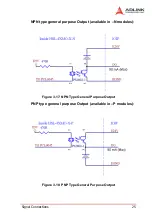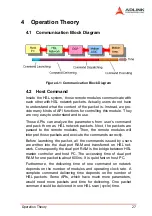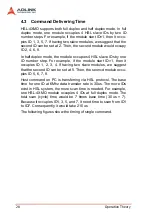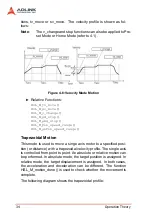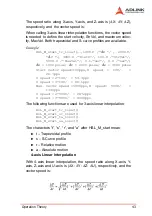
Operation Theory
31
4.5 The role of DSP and motion ASIC
Motion control is executed by motion ASIC. DSP acts as a role to
execute the command dispatching, data management and motion
command sequecing. Motion ASIC is used for generating pulse
trains, position control, dedicated motion I/O control and so on.
There is no motion I/O scan time problem because the ASIC will
take care all of them.
4.6 Motion Control Modes
In this section, the pulse output signal configuration and the follow-
ing motion control modes are described.
Pulse Command Output
The HSL-4XMO uses pulse commands to control servo/stepper
motors via the drivers. A pulse command consists of two signals:
OUT and DIR. There are two command types: (1) single pulse out-
put mode (OUT/DIR), and (2) dual pulse output mode (CW/CCW
type pulse output). The software function,
HSL_M_set_pls_outmode(), is used to program the pulse com-
mand mode. The modes vs. signal type of OUT and DIR pins are
listed in the table below:
The interface characteristics of these signals can be differential
line driver or open collector output. Please refer to section 3.1 for
the jumper setting for different signal types.
Single Pulse Output Mode (OUT/DIR Mode)
In this mode, the OUT signal is for the command pulse (position or
velocity) chain. The numbers of OUT pulse represent the relative
“distance” or “position.” The frequency of the OUT pulse repre-
sents the command for “speed” or “velocity.” The DIR signal repre-
Mode
Output of OUT pin
Output of DIR pin
Dual pulse output (CW/CCW)
Pulse signal in plus
(or CW) direction
Pulse signal in minus
(or CCW) direction
Single pulse output (OUT/DIR)
Pulse signal
Direction signal (level)
Table 4-2: Pulse Command Output
Summary of Contents for HSL-4XMO
Page 4: ......
Page 16: ...6 Introduction ...
Page 36: ...26 Signal Connections ...
Page 67: ...Operation Theory 57 Home Search Example Home mode 1 Figure 4 29 Home Search Example ...
Page 108: ...98 Motion Creator in LinkMaster ...









